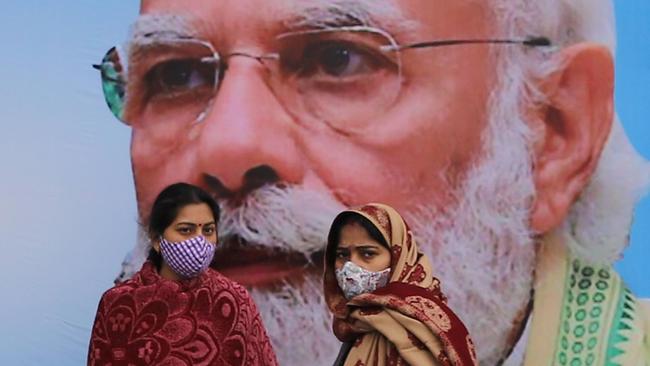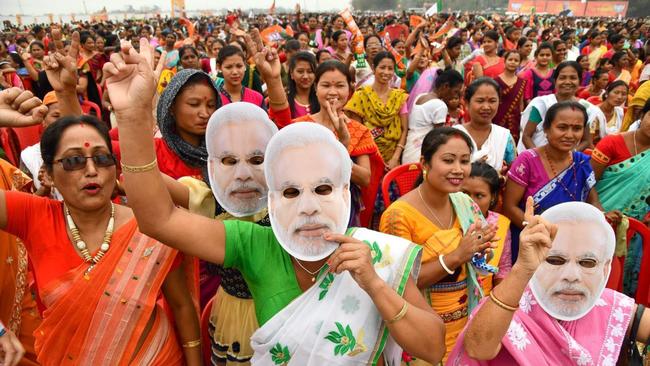India, Covid and Narendra Modi’s fatal flaws
After seven years of demoting minorities, demonising critics and subverting institutions, India's PM remains arguably the 21st century’s most successful democratic politician, and also among its most malevolent.

It had to happen. After weeks of failing, flailing and finger-pointing, Indian Prime Minister Narendra Modi last week received the essential internet tribute to a beleaguered, deluded leader: a Downfall video.
Mumbai filmmaker Satyen Bordoloi’s “Hitler Furious at Lack of Oxygen, Vaccines” features the dictator lamenting that his usual mix of ostentatious piety and overpowering egotism can’t seem to stop COVID-19.
“I never finished school, yet I can talk about exams, write poetry, give scientific opinions to scientists who call me the greatest,” Hitler/Modi raves. “No oxygen my foot!”
Now, he complains, people are criticising his remoteness and callousness, even his pressing on with a $350m overhaul of Delhi’s parliamentary precinct as hundreds of Indians die every hour: “They grumble that I gave no press conference in seven years. They want to stop my 20,000-crore house and office even though they know I am a man of simple tastes. It’s over.”
It’s not, of course. Modi remains arguably the 21st century’s most successful democratic politician, and also among its most malevolent leaders.
After seven years exalting a Hindu state, demoting minorities, demonising critics and subverting institutions, his Bharatiya Janata Party rules the world’s largest democracy root and branch with only fragmentary opposition. But what looked three months ago like his greatest triumph has now led on to his greatest setback.
On February 21, the BJP convened in Delhi to praise itself and felicitate Modi for their achievements in the face of coronavirus last year.
It was resolved that “the party unequivocally hails its leadership for introducing India to the world as a proud and victorious nation in the fight against COVID-19”. It was resolved “with pride that India not only defeated COVID under the able, sensitive, committed and visionary leadership of Prime Minister Shri Narendra Modi, but also infused in all its citizens the confidence to build an ‘Atmanirbhar Bharat’.” This last, a Hindi phrase meaning a “self-reliant India”, is a BJP catchcry.
The praise was not wholly undeserved. India’s first COVID wave claimed tens of thousands of lives but was far less grim than feared, at least statistically. Infections were likely underreported and deaths almost certainly undercounted, but the suffering arose, as it were, as much from the cure as the disease.
Modi’s lockdown was peremptorily imposed, with only hours’ notice, and viciously enforced, resulting in what some deem history’s largest human exodus: millions upon millions of migrant workers forced to walk or cycle from metropolitan areas to their village homes rather than beg, thousands dying along the way, from starvation, exhaustion and accident. The toll has since been memorialised by a fine documentary, Vinod Kapri’s 1232 KMS (2021).

All the same, the steps were decisive and serious. Modi did not minimise COVID a la Bolsonaro, spruik quack cures a la Trump, flap aimlessly like Boris Johnson. He identified personally with the response, setting up his own COVID-relief charity, PM CARES (Citizens Assistance and Relief in Emergency Situations), emblazoned with his image — even if this has since been critiqued as simply a prime ministerial slush fund.
But even in February, the celebrations looked premature. There were signs in the final quarter of 2020 that the COVID-19 virus in India was mutating to become more infectious, more transmissible and more resistant to pre-existing immunity.
In response, virologist Shahid Jameel had been appointed to chair a Scientific Advisory Group for the Indian SARS-CoV2 Consortium on Genomics, tracking the emergence of viral variants, specifically B.1.617 and B.1.1.7.
It was these new virulent strains that were spread on the gusts of Indian exceptionalism. Modi told the Davos elite that India had “saved humanity from a big disaster by containing corona effectively”.
He paralleled the example of the Indian cricket team’s comeback victory in Australia with the nation’s rebound from the adversity of disease.
The BJP became COVID’s saffron superspreader. There was barely a mask in sight as Modi encouraged worshippers to the Kumbh Mela, the Hindu celebration that ranks as the world’s largest religious festival, and threw himself into campaigning for assembly elections in West Bengal, where he revelled in his popularity. “Everywhere I look, as far as I can see, there are crowds!” he exulted a month ago.
The election, controversially stretched to eight stages by an Election Commission that increasingly takes its cues from the BJP, offered an opportunity to defeat the local Trinamool Congress, whose chief minister Mamata Banerjee is an abiding rival, her outward austerity a contrast to Modi’s growing vanity and self-glorification.
Major gains were confidently predicted. But by the time they failed to eventuate, India was in the grip of a harrowing second wave, its vaccine rollout a slow-moving, bureaucratic mess, its management of suddenly scarce oxygen, hospital beds and ventilators a study in ineptitude.
Worse, the government, in contrast to its unilateral approach a year earlier, had a “we-don’t-hold-the-hose” moment, throwing responsibilities back on India’s states, blaming Indians themselves for ignoring COVID protocols — although why would they have maintained them when their leaders had proclaimed the disease in retreat?

So the suffering is one thing; its needlessness another. It has drawn unflattering attention to those aspects of the Modi ascendancy that have confounded the response.
Modi’s rise has always recalled ancient warnings about populism in India. In his famous closing speech to the Constituent Assembly in 1949, B. R. Ambedkar, the father of India’s constitution, spoke of India’s tendency to “Bhakti”, or “the path of devotion or hero-worship”, which was “unequalled in magnitude … in the politics of any other country in the world”.
“Bhakti in religion may be the road to the salvation of the soul,” warned Ambedkar. “But in politics, Bhakti … is a sure road to degradation and to eventual dictatorship.”
In his l’etat c’est moi affectations, Modi also bears some resemblance to the presidential prime ministership of Indira Gandhi, who famously summed up “the issues” of India’s election 50 years ago with the statement: “I am the issue.”
But the BJP’s successes have been more far reaching. In particular, the party’s deep corporate-lined pockets and well-drilled cadres have revolutionised the business of elections, crowding out the Gandhi dynasty and its moribund Congress Party.
The methods first attracted admiring attention in The Modi Effect (2015) by former Tony Blair adviser Lance Price, who describes how Modi’s successful 2014 campaign was guided by a dashing young political consultant, Prashant Kishor, who devised such innovations as “hologram rallies” — public meetings in isolated towns where Modi’s image was beamed on to a stage in 3D by telecom link.
Since then, the BJP’s notorious “IT cells” have harnessed social media as a tool for harassment and intimidation of Modi’s perceived enemies.
“Unless cushioned by wealth or political connections, criticising him is an extremely hazardous undertaking,” observes Kapil Komireddi in Malevolent Republic (2020). “For a man who boasts about the size of his chest, Modi is, unsurprisingly, very thin-skinned.”
This is not a new development. In October 2007, Karan Thapar, India’s No 1 political interviewer, gained the coup of an audience with the coming man, then chief minister of Gujurat. Thapar confronted Modi with his record, his success as a technocrat balanced by his fomenting of religious hatred. In Devil’s Advocate (2018), Thapar describes the ensuing confrontation: “Right through the two or three minutes this exchange lasted, Narendra Modi’s face remained expressionless. But it was also clear he wasn’t happy.
“His eyes were cold and hard. Perhaps he was making an effort to keep his face calm and steady. But now his patience or, perhaps, his resolve snapped. He had had enough and ended the interview. With the words ‘I have to rest. I need some water’ he started to take the microphone off.”

Ten years later, a third party relayed to Thapar the contents of a conversation with Prashant Kishor: “Modi said to Prashant that he will never forgive you and when he gets an opportunity he will take his revenge … and he wouldn’t rest till he had got even with you.” Nowadays, Modi does not even let the media get that close. The Indian public is bombarded with images of Modi, and beguiled by his style: his Modi jackets, his Modi scarves, his fakir-length beard.
But they hear him in only the most authorised and sterilised of guises, such as his monthly fireside chat on All India Radio, Man Ki Baat (Inner Thoughts), his kids’ homily Exam Warriors (2018), and even a bizarre, Putinesque appearance on Bear Grylls’ Man Vs Wild in August 2019. The country’s Right to Information Act, meanwhile, has been gutted.
India has some of the world’s most courageous journalists: close to 200 have died in the act of documenting this second wave, filming in overcrowded wards, counting funeral pyres. It also has some of the world’s most craven and biddable, their output barely distinguishable from government propaganda.
Add to this Modi’s Trumpesque contempt for expertise — or, as he puts it, preference for “hard work over Harvard”, as though the two are mutually exclusive.
Consider the recent fate of scientist Shaheen Jameel. In an oped in The New York Times on May 13, Jameel wrote that vaccination in India had been “hobbled by messages from Indian leadership that the country had conquered the virus”, and that “decision-making based on data” had become “yet another casualty” of the pandemic’s spread.
A day later he was gone, saying only: “I am not obliged to give a reason.” Nobody even batted an eyelid.

In forthcoming Modi’s India: Hindu Nationalism and the Rise of Ethnic Democracy (2021), Christophe Jeffrelot, professor of Indian Studies at King’s College, argues for the Modi government to be considered as practising a form of “competitive authoritarianism” — “an ‘ism’ that makes some room for the people’s voice — as required by populism”.
Ours, says Jeffrelot, is no longer the age of violent coups and revolutions — instead democracy dies by degrees, beneath a veneer of legality, as representation loses its importance relative to promises of security.
Another concept has been mooted by Neelanjan Sircar, an assistant professor at Ashoka University, who argues that Modi’s 2019 re-election manifested “vishwas (trust) politics”.
Rather than a model of economic accountability in which they reward politicians for improving their quality of life, says Sircar, voters in India were now motivated by a simple faith in centralised power, its rising above the messiness of negotiation.
Uniquely Indian? Probably not. An observable reality of the last decade is that people everywhere love the spectacle of power, are invigorated by the spirit of contempt, are impatient with the management and accommodation of differences.
At the end of Bordoloi’s video, Hitler/Modi’s deferential courtiers reassure him. “The periodic element has 117 elements that I can breathe!” says one. “I’ll go and live on Mars!” promises another. It’s their equivalents, Modi’s fawning enablers, who perhaps really have the case to answer.

To join the conversation, please log in. Don't have an account? Register
Join the conversation, you are commenting as Logout